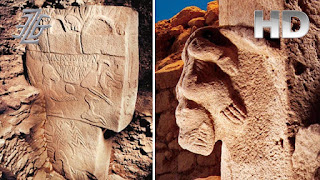I know, I know, I rant and rave about this place, but truly, it's completely turned huemahn history on it's head. And since it's been uncovered, more finds have continued to turn our history on it's head.
See, we go by what the books say, we go by what the TV says, and those people have a lot of money invested in the status quo. So when things like Gobekli Tepe pop up, or when they find that huemahns were in North America thousands of years before the books say so, well, it fucks with their plans.
AND... When you look at these photo's, just remember, these were done at a time, 6000 years before the pyramids, before Stonehenge.. Built, carved at a time when we huemahns were 'Hunter gatherers' and by 'history's' books, were NOT supposed to be able to pull this off. AND, this enclosure that you see is just ONE, there's over 6 football fields burried here with other enclosures yet to be unearthed
Moving Target: Civilization's Real Age
(newsmax.com) - - For many centuries the prevailing scholarly opinion has been that the dawn of civilization could be dated to approximately 5,000 years ago. The invention of writing was the seminal event in that calculus, with both the earliest hieroglyphics and cuneiform in Egypt and Mesopotamia respectively going back to circa 3,200 BC.
Generations of humans prior to that arbitrary date have tended to be categorized somewhat dismissively, more in the vein of cave-dwellers, nomadic wanderers, and primitive farmers and shepherds. They were considered literally "pre-historic," as they existed before stylus was ever put to papyrus or clay tablet.
The recent archaeological finds in Turkey at Gobekli Tepe however have turned that perspective on its head. The site was first noted in 1963 by a joint Turkish/American survey, but only unearthed and properly documented by a team led by Klaus Schmidt of the German Archaeological Institute beginning in 1995.
The work is ongoing at present, but what is known already is that the complex at Gobekli Tepe is extensive, sophisticated, colossal and ancient beyond belief — pre-dating the Fertile Crescent societies by some 6,000 years. Gobekli Tepe was built around 9,000 B.C., just after the last ice age ended.
Everything that was thought to be known about the role of the earliest religions, the invention of agriculture, and the birth of sedentary society has to be rewritten in the light of these discoveries of the last few years in the Eastern Anatolian region of Turkey.
The astounding mastery of engineering, construction techniques, project management, and the artistic and aesthetic nuances exemplified in the architecture of this complex point to skill sets that are many thousands of years ahead of their time. The massive pillars at Gobekli Tepe, displaying intricately carved stylized figures in bas relief, weigh between twenty and sixty tons, and are crowned with capstones which themselves tip the scales at ten tons.
Specialists in quite a few fields are having some difficulty giving apt explanations for these enigmatic ruins.
Hard on the heels of one shock in Turkey comes yet another even more mind-boggling stunner from North Africa. According to the experts, Homo sapiens had been deemed to be 200,000 years old — but that was last years’ reckoning. Paleoanthropologists in June of 2017 published their findings in the esteemed scientific journal, Nature, concerning human fossil and bone specimens found in a cave at Jebel Irhoud in Morocco.
The pronouncement of the researchers was sufficiently eye-opening; they had come to the flabbergasting realization that these particular Homo sapiens lived some 300,000 years ago. This conclusion has pushed back the timeline for our species to "a time and a half older than anything else put forward," says John Fleagle of the State University of New York (SUNY).
The astonishing results from Jebel Irhoud have graced mankind with an immediate upgrade in seniority — the human race is now judged to be close to one-third of a million years old.
"These dates were a big wow," commented Professor Jean-Jacques Hublin, of the Max Planck Institute for Evolutionary Anthropology in Leipzig, Germany, where the radioluminescence dating on a tooth and stone tools found at the site was performed. "This material represents the very root of our species."
And such a sea-change in how far back those roots stretch may give rise to a change in perception about ourselves.
Humanity, we now realize, has been on Earth long enough to have seen multiple ice ages come and go, along with the interglacials between them, as well as the current span of 12,000 years of clement climate currently enjoyed. In all that time billions of outbreaks of disease, drought, famine, earthquakes, volcanoes, wildfires and every other mode of fatality has taken constant aim at Homo sapiens, who remains standing in spite of it all.
Since a Tunguska-sized asteroid/meteor collision event occurs on average every 10,000 years — the kind that shook a great portion of Siberia in 1908 — our forebears have also withstood some thirty such assaults even from outer space.
And, as our Moon inches away currently only at the rate of 3.8 centimeters per year, since those earliest humans lit their campfires at Jebel Irhoud our gutsy ancestors looking up at the sky have witnessed it wheel out some 11.5 kilometers further away from the Earth, the same planet over which they established their utter dominion in all that time.
In contrast to the dystopian outlooks that foretell the eventual demise of the human race, the abiding evidence over seemingly interminable ages is that the one immutable attribute of our kind is the ability to endure.




No comments:
Post a Comment